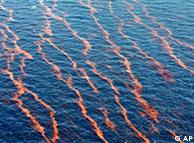Oil spill efforts fail; BP calls on general public for suggestions
BP's 100-ton containment dome failed to funnel oil leaks that have been
polluting the Gulf of Mexico for over two weeks. As the slick reaches US
shores, BP wants you to come up with a solution.
The 100-ton containment dome that BP hoped would stop an ongoing
oil spill into the Gulf of Mexico, has failed after clogging with ice
crystals.
The dome, which was lowered to the seafloor last Thursday, was meant
to funnel leaking crude into a rigger. The oil has been shooting into
the Gulf at a rate of 5,000 barrels (210,000 gallons) per day, since an
April 20 explosion off the coast of Louisiana that left 11 missing and
presumably dead.
With no quick fix in sight now and the oil slick reaching shorelines,
BP is calling on clever non-experts to come up with solutions. BP is putting a brave face on their current dilemma, which is
bringing them tens of millions of dollars in new lawsuits, and costing
them six million dollars (4.6 million euros) in cleanup each day.
 Bildunterschrift:
Großansicht des Bildes
mit der Bildunterschrift: BP's
100-ton containment dome filled with ice crystals instead of funneling
oil Bildunterschrift:
Großansicht des Bildes
mit der Bildunterschrift: BP's
100-ton containment dome filled with ice crystals instead of funneling
oil
"I wouldn't say it's failed yet," said Doug Suttles, BP's Chief
Operating Officer, the day after ice crystals clogged the containment
dome. "What I would say is, what we attempted to do last night didn't
work."
BP is considering using a smaller containment dome that will be less
prone to clogging. Admiral Thad Allen, head of the US Coast Guard, also
told CBS television that a type of plug was also being considered.
"They're actually going to take a bunch of debris – shredded up
tires, golf balls and things like that – and under very high pressure
shoot it into the preventer itself and see if they can clog it up and
stop the leak."
However, experts warn that if such a procedure failed, it could cause
the flow of the oil to increase exponentially. The only sure option,
geologist Lorenz Schwark told Deutsche Welle, is to drill a relief well
to intercept the original well and to fill it with very heavy cement
that would block the oil's flow. This process was used once in the Gulf
of Mexico in 1979; at the time taking 10 months. This time, he
estimates, it will take about three.
 Bildunterschrift: Großansicht des Bildes
mit der Bildunterschrift: With
no quick fix in sight, BP is looking for clever ideas from the public Bildunterschrift: Großansicht des Bildes
mit der Bildunterschrift: With
no quick fix in sight, BP is looking for clever ideas from the public
Publically flummoxed – and threatened by a drastic loss of face – BP
has launched the website www.deepwaterhorizonresponse.com to collect
creative ideas from the general public on how to solve the spill.
Submissions are then forwarded to engineers.
BP spokesperson Bryan Ferguson told reporters in Louisiana that he
had "no idea" to what extent these suggestions were being worked on, but
said that BP had "flown in experts from around the world to collaborate
and contemplate the ideas that are presented."
Most of the ideas being presented are probably not feasible,
unfortunately. Professor Schwark at the University of Kiel said that he
has received a number of emails himself in recent days from individuals
wanting to present him their own ideas.
"Most of them were quite drastic, including planting a nuclear device
on the seafloor and just blowing up the whole area," he said. "I was
wondering whether people do consider the effects of such an event if
carried out under water in the real world, and not just in a comic
film." Some initiatives led by non-experts are already underway along the
threatened Gulf shoreline. In Walton County, Florida, Sheriff Michael A.
Adkinson unveiled his plan to protect 42 kilometers of white, sandy
beaches. Adkinson has hired a private contractor to float several barges
loaded with 1,400 pound (635 kilogram) bales of hay into the Gulf,
which will then be shredded and blown onto the surface of the water,
where he believes it will absorb the oil.
 Bildunterschrift: Großansicht des Bildes
mit der Bildunterschrift: Already
doing damage to marine life, the spill threatens shorelines as well Bildunterschrift: Großansicht des Bildes
mit der Bildunterschrift: Already
doing damage to marine life, the spill threatens shorelines as well
As for the source of the problem, Schwark said, if his three-month
estimation for relief efforts is correct and the oil flow remains
constant, the amount spilled will total around 40 thousand tons, equal
to the amount of oil leaked during the Alaskan Exxon-Valdez disaster in
1989 – the biggest in US history to date.
Schwark added that, given the 80-kilometer (50-mile) distance from
the shoreline in this case, he didn't think the overall environmental
impact would be as devastating as in Alaska.
Said Mary Landry of the US Coast Guard, "I don't think any of us know
at this time what the impact will be on the environment, or the
economic issues that are associated with this spill."
Author: David Levitz
Editor: Mark Mattox http://www.dw-world.de/dw/article/0,,5560673,00.html
| 








